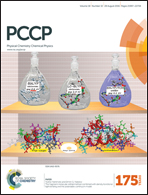Electronic absorption spectra of imidazolium-based ionic liquids studied by far-ultraviolet spectroscopy and quantum chemical calculations†
Abstract
Electronic absorption spectra of imidazolium-based ionic liquids were studied by far- and deep-ultraviolet spectroscopy and quantum chemical calculations. The absorption spectra in the 145–300 nm region of imidazolium-based ionic liquids, [Cnmim]+[BF4]− (n = 2, 4, 8) and [C4mim]+[PF6]−, were recorded using our original attenuated total reflectance (ATR) system spectrometer. The obtained spectra had two definitive peaks at ∼160 and ∼210 nm. Depending on the number of carbon atoms in the alkyl side chain, the peak wavelength around 160 nm changed, while that around 210 nm remained at almost the same wavelength. Quantum chemical calculation results based on the time-dependent density functional theory (TD-DFT) also showed the corresponding peak shifts. In contrast, there was almost no significant difference between [C4mim]+[BF4]− and [C4mim]+[PF6]−, which corresponded with our calculations. Therefore, it can be concluded that the absorption spectra in the 145–300 nm region are mainly determined by the cations when fluorine-containing anions are adopted. In addition, upon addition of organic solvent (acetonitrile) to [C4mim]+[BF4]−, small peak shifts to the longer wavelength were revealed for both peaks at ∼160 and ∼210 nm. The peak shift in the deep-ultraviolet region (≤200 nm) in the presence of the solvent, which indicates the change of electronic states of the ionic liquid, was experimentally observed for the first time by using the ATR spectrometer.


 Please wait while we load your content...
Please wait while we load your content...